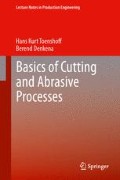Abstract
The use of simulations in the field of machining is generally based on the combination of numerical methods or on the algorithmic geometry with the manufacturing processes, which are dealt with in this book. Therefore, not only the input data of the simulation, but also and especially the underlying models are crucial for the value and the expressiveness of the simulation.
Access this chapter
Tax calculation will be finalised at checkout
Purchases are for personal use only
Notes
- 1.
In the presented example a semi empirical force model introduced by Altintas was used to determine the forces. See also [ALT00].
References
Altintas, Y.: Manufacturing Automation: Metal Cutting Mechanics, Machine Tool Vibrations and CNC Design. Cambridge University Press, Cambridge (2000)
Deichmüller, M., Denkena, B., Payrebrune, K.M.; Kröger, M., Wiedemann, S., Schroeder, A, Carstensen, C.: Determination of static and dynamic deflections in tool grinding using a dexel-based material removal simulation
Denkena, B., Tracht, K., Rehling, S.: Technological NC-simulation–bringing NC-simulation to the next level. In: Proceedings of the 5th CIRP International Seminar on Intelligent Computation in Manufacturing Engineering, 25–28 July 2006, pp. 257–260 Ischia, Italien
Denkena, B., Schmidt, C.: A flexible force model for predicting cutting forces in end milling. Prod. Eng. 1, S343–350 (2007)
Denkena, B., Deichmüller, M., Kröger, M., Popp, K.M., Carstensen C., Schroeder, A., Wiedemann, S.: Geometrical analysis of the complex contact area for modeling the local distribution of process forces in tool grinding. In: Proceedings of the 1st International Conference on Process Machine Interactions, Hannover, S. 289–298 (2008)
Heinzel, C.: Scheifprozesse verstehen [To Understand Grinding Processes]. Habil. Schrift Univ., Bremen (2009).
Ikawa, N., Shimada, S., Ohmori, G., Tanaka, H.: Moleculardyna-mics analysis as compared with results of micromachining. Ann. CIRP 41(1), S. 117–120 (1992)
ISO 3592:2000: Industrial automation systems—Numerical control of machines—NC processor output—File structure and language format. International Organization for Standadization (2000)
Lin, Z.C., Pan, W.C.: A thermo-plastic large deformation model of orthogonal cutting with tool flank wear—part 1: computual procedures. Int. J. Mech. Sci., Bd. 35, Heft 10, S. 829–840 (1993)
N.N.: MARC Volume A: Theory and User Information, Version 7.3, Part Number RF-3001-07.3. Revision Date: August 1998, MARC Analysis Research Corporation
Meir, G., Hashemi, J., Chou, P.C.: Finite-Element Simulation of Segmented Chipping in High-Speed Machining, p. MR88-120. Society of Manufacturing Engineers, Dearborn, Mi, USA (1988)
Rentsch, R.: Molecular dynamics simulation for nanometer chip removal processes. PhD-Dissertation, Keio University (1995)
Rentsch, R.: Molucular dynamics of nanoscale cutting. In: Davim, J.P., Jackson, M.J. (eds.) Nano and Micromachining. ISTE-Wiley Publ, NY (2009). ISBN 978-1-84821-103-2
Strenkowski, J.S., Moon, K.J.: Finite element prediction of chip geometry and tool/workpiece temperature distribution in orthogonal metal cutting. J. Eng. Indus., Bd. 112, Heft 4, S. 313–318 (1990)
Stroud I.: Boundary representation modelling techniques. Springer Verlag, London (2006)
Weinert, K., Stautner, M.: An efficient discrete simulation for five-axis milling of sculptured surfaces. Prod. Eng. IX/1 (2002), S. 47–51
Weinert, K., Kersting, P., Surmann, T., Biermann, D.: Modeling regenerative workpiece vibrations in five-axis milling. Prod. Eng. 2(3):S. 255–260
Zhang, B., Bagachi, A.: Finite element simulation of chip formation and comparison with machining experiment. J. Eng. Indus. 116:S. 289–297 (1994)
Author information
Authors and Affiliations
Corresponding author
Rights and permissions
Copyright information
© 2013 Springer-Verlag Berlin Heidelberg
About this chapter
Cite this chapter
Tönshoff, H.K., Denkena, B. (2013). Modeling and Simulation. In: Basics of Cutting and Abrasive Processes. Lecture Notes in Production Engineering. Springer, Berlin, Heidelberg. https://doi.org/10.1007/978-3-642-33257-9_6
Download citation
DOI: https://doi.org/10.1007/978-3-642-33257-9_6
Published:
Publisher Name: Springer, Berlin, Heidelberg
Print ISBN: 978-3-642-33256-2
Online ISBN: 978-3-642-33257-9
eBook Packages: EngineeringEngineering (R0)

